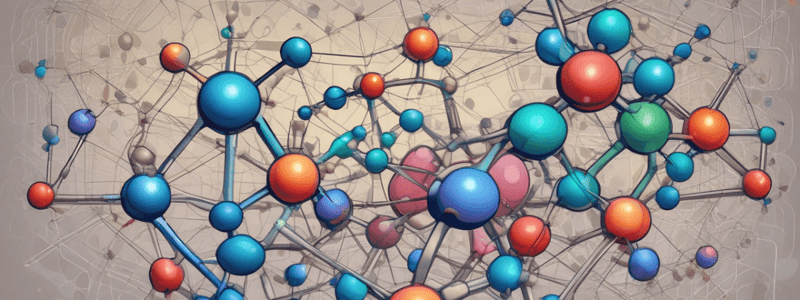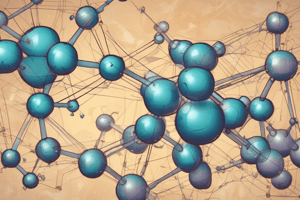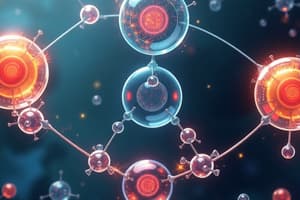Podcast
Questions and Answers
What is the reason for the increase in alkene C=C bond length on binding?
What is the reason for the increase in alkene C=C bond length on binding?
- The M−alkene σ bond depletes the C=C π bond by donation to M
- The C=C π bond is depleted by back donation from the metal and the M−alkene σ bond (correct)
- The C=C π bond is strengthened by the M−alkene σ bond
- The C=C π bond is strengthened by back donation from the metal
What is the characteristic of the C−H bonds in strongly π basic Pt(0) complexes?
What is the characteristic of the C−H bonds in strongly π basic Pt(0) complexes?
- They are unaffected by the metal
- They are bent away from the metal to a small extent
- They are aligned towards the metal
- They are bent away from the metal to a much bigger extent (correct)
What is the effect of electron-withdrawing substituents on carbon on the M-(alkene) bond?
What is the effect of electron-withdrawing substituents on carbon on the M-(alkene) bond?
- They strengthen the M-(alkene) bond (correct)
- They break the M-(alkene) bond
- They weaken the M-(alkene) bond
- They have no effect on the M-(alkene) bond
What is the difference between the D-C and MCP models?
What is the difference between the D-C and MCP models?
What is the length of the C=C bond in free C2H4?
What is the length of the C=C bond in free C2H4?
What is the characteristic of the carbons in an MCP C2H4 complex?
What is the characteristic of the carbons in an MCP C2H4 complex?
What is the approximate angle that the C1 and C4 substituents twist out of the plane of the ligand?
What is the approximate angle that the C1 and C4 substituents twist out of the plane of the ligand?
What is the average length of the C1–C2 and C3–C4 distances?
What is the average length of the C1–C2 and C3–C4 distances?
Which molecular orbitals dominate the bonding to the metal?
Which molecular orbitals dominate the bonding to the metal?
What is the result of σ donation to the metal and back donation from the metal on the C1–C2 and C2–C3 distances?
What is the result of σ donation to the metal and back donation from the metal on the C1–C2 and C2–C3 distances?
At which carbon atom can protonation occur?
At which carbon atom can protonation occur?
What is the result of M–L binding on the ligand HOMO and LUMO?
What is the result of M–L binding on the ligand HOMO and LUMO?
What happens to the metal in a fluxional η1-Cp group?
What happens to the metal in a fluxional η1-Cp group?
How many MOs are formed from the five carbon p orbitals in the MO scheme of Fig. 5.3?
How many MOs are formed from the five carbon p orbitals in the MO scheme of Fig. 5.3?
Which metal orbital interacts with ψ1 in Fig. 5.3b?
Which metal orbital interacts with ψ1 in Fig. 5.3b?
Why is the Cp group not a good π acceptor?
Why is the Cp group not a good π acceptor?
What must be considered in the MO diagram for a Cp2M metallocene?
What must be considered in the MO diagram for a Cp2M metallocene?
What is the effect of the anionic charge on Cp complexes?
What is the effect of the anionic charge on Cp complexes?
What is the purpose of using Et3O+ in complexes?
What is the purpose of using Et3O+ in complexes?
What is the characteristic of the η8cyclooctatetraene (cot) hydrocarbon?
What is the characteristic of the η8cyclooctatetraene (cot) hydrocarbon?
What type of complexes can early metals form with η8-C8H8?
What type of complexes can early metals form with η8-C8H8?
What is the term used to describe fragments that are very dissimilar in composition but have similar frontier orbitals?
What is the term used to describe fragments that are very dissimilar in composition but have similar frontier orbitals?
What is the characteristic of the frontier orbitals of isolobal fragments?
What is the characteristic of the frontier orbitals of isolobal fragments?
What is the symmetry of the pair of ψ1 orbitals from each ring?
What is the symmetry of the pair of ψ1 orbitals from each ring?
What is the result of replacing one CH of benzene by a metal fragment isolobal with CH?
What is the result of replacing one CH of benzene by a metal fragment isolobal with CH?
Which metal orbital does the opposite combination of ψ1 orbitals interact with?
Which metal orbital does the opposite combination of ψ1 orbitals interact with?
What is the pattern of d-orbital splitting in Cp2M?
What is the pattern of d-orbital splitting in Cp2M?
Which metallocenes are the most stable?
Which metallocenes are the most stable?
What is the result of the bonding and nonbonding orbitals being exactly filled in Cp2Fe?
What is the result of the bonding and nonbonding orbitals being exactly filled in Cp2Fe?
Why is the MCp2 unit intrinsically stable?
Why is the MCp2 unit intrinsically stable?
Flashcards are hidden until you start studying
Study Notes
Experimental Structures
- Experimental structures of metal-alkene complexes can fall between two extremes: Dewar-Chatt-Duncanson (D-C) model and Metal-Centered (MCP) model.
- The D-C model fits best for intermediate oxidation state late metals, such as Zeise's salt, while the MCP model applies for Pt(0).
- Both models are considered η2 structures.
Metal-Alkene Bonding
- The alkene C=C bond length increases on binding due to two reasons:
- M-alkene σ bond depletes the C=C π bond by donation to M, slightly weakening and lengthening the bond.
- Back donation from the metal lowers the alkene C-C bond order by filling C=C π*.
- For weakly π-basic Pt(II), the D-C model results in a slight reduction in bond length, while for strongly π-basic Pt(0), the MCP model applies, leading to a longer C=C bond length.
η2 Complexes
- Electron-withdrawing substituents on carbon encourage back donation and strengthen the M-alkene bond.
- The bonds to the four substituents of the alkene are bent away from the metal to a small extent in the D-C case, but to a much bigger extent in an MCP complex.
- The C1 and C4 substituents twist 20-30° out of the plane of the ligand and bend back to overlap better with the metal.
Diene Complexes
- The butadiene frontier orbitals, ψ2 (HOMO) and ψ3 (LUMO), dominate bonding to the metal.
- The MO diagram shows that both depletion of electron density in ψ2 by σ donation to the metal and population of ψ3 by back donation from the metal lengthen C1-C2 and shorten C2-C3.
- Protonation can occur at C1 where the HOMO, ψ2, has its highest coefficient.
Isolobal Replacement and Metallocycles
- The chemical character of a fragment depends on the symmetry and electron occupation of the frontier orbitals.
- Fragments that are very dissimilar in composition can have similar frontier orbitals, known as isolobal fragments.
- Isolobality helps in understanding metallabenzenes, in which we replace one CH of benzene by a metal fragment isolobal with CH.
η8 Ligands
- The antiaromatic 8π electron, nonplanar hydrocarbon, η8-cyclooctatetraene (cot), can form complexes as the reduced, aromatic 10πe cot2− dianion.
- Early metals that need many electrons to achieve an 18e structure can also give η8-C8H8 complexes.
Cyclopentadienyl Complexes
- The η1-Cp group can be fluxional, in which case the metal rapidly moves around the ring to make all the protons equivalent.
- The MO scheme for M-C5H5 shows that the five carbon p orbitals lead to five MOs for the C5H5 group.
- The most important overlaps are ψ1 with the metal dz2, and ψ2 and ψ3 with the dxz and dyz orbitals.
Metallocenes
- The MO diagram for a Cp2M metallocene requires consideration of both Cp groups.
- The bonding scheme retains both the L→M direct donation and the M→L back donation, as well as a d-orbital splitting pattern that broadly resembles the two-above-three pattern characteristic of an octahedral crystal field.
- The MCp2 unit is intrinsically stable, and the same structure is adopted for numerous first-row transition metals, even when this results in a paramagnetic, non-18e complex.
Studying That Suits You
Use AI to generate personalized quizzes and flashcards to suit your learning preferences.




